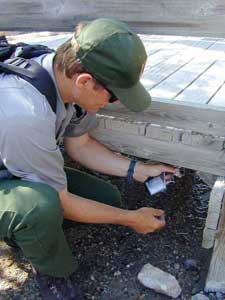|
Recent eruptions, 200 degree ground
temperatures, bulging magma and 84 degree water
temperatures prompt heightened scrutiny of park's
geothermal activity
 The
U.S. Geological Service and the media have been
super-conservative with their warnings about the
Yellowstone supervolcano. But evidence is accumulating
that the park is in big trouble because the vast
volcanic region beneath its surface could be on a fast
track to eruption. One source says, "The American people
are not being told that the explosion of this 'super
volcano' could happen at any moment. The
U.S. Geological Service and the media have been
super-conservative with their warnings about the
Yellowstone supervolcano. But evidence is accumulating
that the park is in big trouble because the vast
volcanic region beneath its surface could be on a fast
track to eruption. One source says, "The American people
are not being told that the explosion of this 'super
volcano' could happen at any moment.
When
Yellowstone does blow, some geologists predict that
every living thing within six hundred miles is likely to
die.
The
Idaho Observer reports that recent eruptions, 200 degree
ground temperatures, bulging magma and 84 degree water
temperatures are worrying scientists who are studying
the area. Yellowstone National Park is on top of one of
the largest "super volcanoes" in the world, with a
regular eruption cycle of 600,000 years. The last
eruption was 640,000 years ago-meaning the next one is
long overdue, and it could be 2,500 times the size of
the 1980 Mount St. Helens eruption.
During December,
2003, 56 earthquakes were located in the Yellowstone
region, according the the Yellowstone Volcano
Observatory.
Idaho Observer
 BILLINGS,
Mont. -- Yellowstone National Park happens to be on
top of one of the largest "super volcanoes" in the
world. Geologists claim the Yellowstone Park area has
been on a regular eruption cycle of 600,000 years. The
last eruption was 640,000 years ago making the next one
long overdue. This next eruption could be 2,500 times
the size of the 1980 Mount St. Helens eruption.
Volcanologists have been tracking the movement of magma
under the park and have calculated that, in parts of
Yellowstone, the ground has risen over seventy
centimeters this century. BILLINGS,
Mont. -- Yellowstone National Park happens to be on
top of one of the largest "super volcanoes" in the
world. Geologists claim the Yellowstone Park area has
been on a regular eruption cycle of 600,000 years. The
last eruption was 640,000 years ago making the next one
long overdue. This next eruption could be 2,500 times
the size of the 1980 Mount St. Helens eruption.
Volcanologists have been tracking the movement of magma
under the park and have calculated that, in parts of
Yellowstone, the ground has risen over seventy
centimeters this century.
In July, 2003, Yellowstone Park rangers closed the
entire Norris Geyser Basin because of deformation of the
land and excessive high ground temperatures. There is an
area that is 28 miles long by 7 miles wide that has
bulged upward over five inches since 1996, and this year
the ground temperature on that bulge has reached over
200 degrees (measured one inch below ground level).
There was no choice but to close off the entire area.
Everything in this area is dying: The trees, flowers,
grass and shrubs. A dead zone is developing and
spreading outward. The animals are literally migrating
out of the park.
Then during the last part of July one of the Park
geologists discovered a huge bulge at the bottom of
Yellowstone Lake. The bulge has already risen over 100
feet from the bottom of the lake and the water
temperature at the surface of the bulge has reached 88
degrees and is still rising.
 Keep
in mind that Yellowstone Lake is a high mountain lake
with very cold water temperatures. The Lake is now
closed to the public. It is filled with dead fish
floating everywhere. The same is true of the Yellowstone
river and most of the other streams in the Park. Dead
and dying fish are filling the water everywhere. Keep
in mind that Yellowstone Lake is a high mountain lake
with very cold water temperatures. The Lake is now
closed to the public. It is filled with dead fish
floating everywhere. The same is true of the Yellowstone
river and most of the other streams in the Park. Dead
and dying fish are filling the water everywhere.
Many of the picnic areas in the Park have been closed
and people visiting the Park usually stay but a few
hours before leaving since the stench of sulfur is so
strong they literally can't stand the smell.
The irony of all this is the silence by the news
media and our government. Very little information is
available from Yellowstone personnel or publications.
What mainstream news stories do appear underscore the
likelihood of a massive volcanic eruption. Though
geologists publicly admit Yellowstone is "overdue," they
have been quoted as stating another massive magma
release may not occur for 100,000 or 2 million years.
Others close to the story are convinced that a massive
eruption is imminent. A source that has demonstrated
first-hand knowledge of the park's history and recent
geothermal events stated the following: "The American
people are not being told that the explosion of this
'super volcano' could happen at any moment. When
Yellowstone does blow, some geologists predict that
every living thing within six hundred miles is likely to
die. The movement of magma has been detected just
three-tenths of a mile below the bulging surface of the
ground in Yellowstone raising concerns that this super
volcano may erupt soon."
|